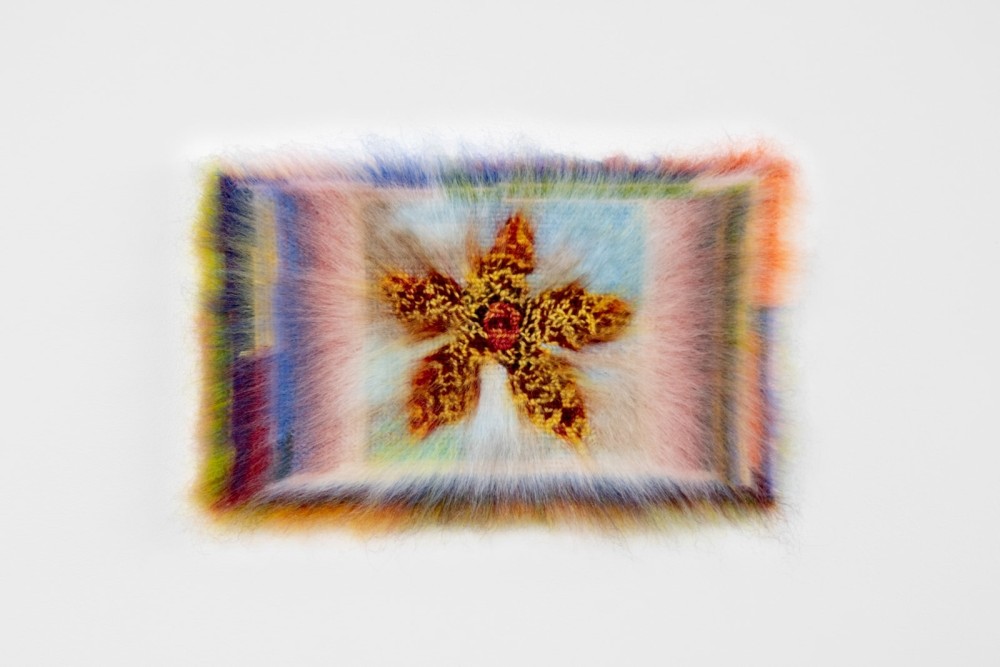
Maria Szakats: Hover
Megan Mulrooney is thrilled to present Hover, an exhibition of textile works by Maria Szakats, an Austrian artist based in Paris. Her first solo exhibition in the United States, Hover evokes a state of suspended transformation, where images seem to form and dissolve in a perpetual flux. Her embroidered and brushed mohair surfaces create compositions that resist stillness—hovering between presence and disappearance.
At the core of Hover is an exploration of floral motifs—orchids, peonies, dahlias, fire lilies, and tulips—woven into a personal and allegorical language. Flowers, long imbued with symbolic weight in art and literature, have served as emblems of transience, beauty, and mourning. In Szakats’ work, they become agents of transformation, rooted in the artist’s own deep memory.
As a child, Szakats spent a formative year with her grandmother in Hungarian Romania, separated from her parents who had relocated to Austria as political refugees. Her grandmother’s home was lined with insulating, embroidered textiles, their floral patterns covering every wall. This immersive visual environment, at once comforting and claustrophobic, shaped her aesthetic sensibility, becoming a motif that has followed her throughout her life. This recurrence was intensified by a revelatory experience in her twenties, when a hallucinogenic trip in a flower-wallpapered apartment in Vienna brought these images back with unsettling force. As she lay on a couch, the ceiling seemed to lift, revealing an apocalyptic, fast-moving sky, while the floral patterns surrounding her pulsed with motion. This vision—of beauty dissolving into unease, of a world teetering between familiarity and disorientation—resonates throughout Hover, where floral forms float against unreal, fire-tinged skies, imbuing the works with an atmosphere of both nostalgia and premonition.
Formally, Hover marks a departure from Szakats’ previous series, which incorporated photographic and AI-generated motifs drawn from Renaissance and medieval painting fragments. Here, she moves toward self-composed imagery, constructing environments where flowers inhabit interior spaces or exist in ambiguous landscapes beneath unnatural skies. A work titled Twist serves as a conceptual bridge between past and present, carrying forward elements of her earlier investigations while signaling new directions.
A sense of liminality pervades the exhibition, evoking the Hanged Man from the Tarot de Marseille—a figure suspended in a state of anticipation, caught between revelation and impending doom. This feeling of unresolved tension is perhaps most pronounced in the titular work Hover, where two orchids appear in precarious balance, one looming as a shadowed specter in the background. Elsewhere, in an untitled piece, Szakats disrupts conventional depth perception by embroidering onto an already brushed surface, further complicating the foreground-background relationship and heightening the sense of instability.
A key reference for Szakats is René Magritte’s The Tomb of the Wrestler, a painting that unsettles perception, placing objects in a state of enigmatic suspension. In Hover, she extends this logic, crafting a world where embroidery dissolves into atmosphere, where flowers waver between memory and premonition, and where the sky—whether tormented or ablaze—remains in constant motion. The works linger in this suspended space, neither arriving nor departing, but always on the cusp of transformation.
Maria Szakats (b. Romania, 1984; lives and works in Paris) holds an MFA from the Ecole Nationale Supérieure des Arts Décoratifs. She has had solo exhibitions with Brooke Benington in London, Galerie Chloe Salgado in Paris, along with numerous two-person and group exhibitions.